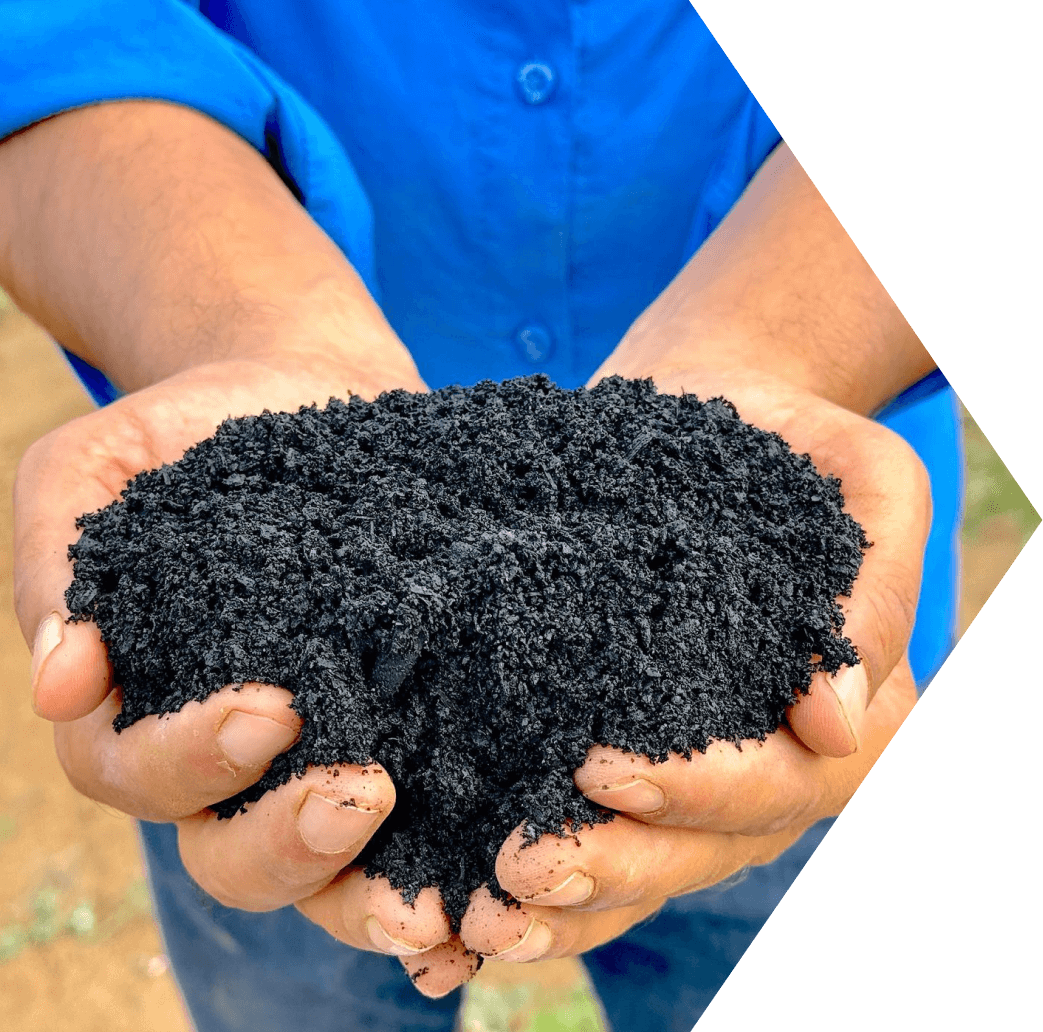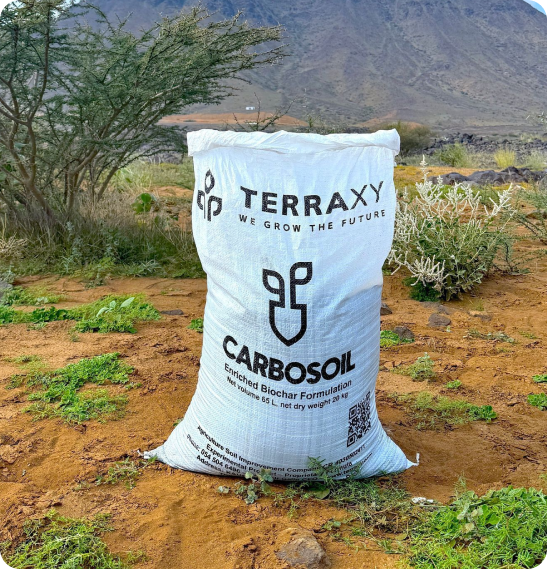
Carbosoil mixed into the soil
more water retention
more nutrient retention
growth enhancement potential
2 Sustainable Carbon capture credits per ton
ton CO₂e/ton of Carbosoil | Or equivalent 0.64 ton CO₂e/m³ of Carbosoil Or roughly 1 credit for every 60 m2 or your garden.
SAR/m³ of soil mix.
No need for any peat moss, perlite or compost.
| Carbosoil | Typical Soil Mix | Biochar | |
|---|---|---|---|
| Required Dose | 5% CARBOSOIL | 10% PEAT MOSS, 6% COMPOST, 5% PERLITE | NOT RECOMMENDED FOR SAUDI SOILS |
| Cost per Application | 64 SAR/m³ $17.06 USD/m³ | 68 SAR/m³ $18.13 USD/m³ | - |
| Nutrient Density | SAME | SAME | HIGHER |
| Initial Growth Enhancement | SAME | SAME | NEGATIVE |
| Long-term Growth Enhancement | UP TO 70% | NEGLIGIBLE | NEGATIVE |
| Material Stability | 100+ YEARS | 1.5 YEAR | 100+ YEARS |
| Material remaining in the soil | after 1st year: 100% after 2nd year: 100% | after 1st year: 19% after 2nd year: 3% | after 1st year: 100% after 2nd year: 100% |
| Nutrient Retention | after 1st year: 53% after 2nd year: 53% | 50% 1% | - - |
| Water Retention | after 1st year: +11% after 2nd year: +11% | after 1st year: +11% after 2nd year: +1% | - - |
| Sustainability | BEST FOR ENVIRONMENT 2 CARBON CREDITS PER TON | BAD CARBON EMITTING | BEST FOR ENVIRONMENT 2 CARBON CREDITS PER TON |

| Parameter | Method | Unit | Value | Range | Comment |
|---|---|---|---|---|---|
| Water holding capacity (WHC) | DIN EN ISO 17828: 2016-05 | % (w/w) | 184.5 | 180-190 | Permanent, long-term stability guarantees that the WHC and CEC will remain for the lifetime (100+ years). |
| Water holding capacity (WHC) | DIN EN ISO 17828: 2016-05 | % (v/v) | 59 | 57-61 | |
| Cation exchange capacity (CEC) | Rayment & Lyons 2011-15D3 | cmol/L | 17.2 | >16 | |
| pH (in CaCl₂) | DIN ISO 10390: 2005-12 | 7.0 | <8.5 | Nutrient is made available despite pH value up to 8.5. Reject if pH above 8.5. | |
| Conductivity | 1:10 solid:water method | dS/m or mS/cm | 1.5 | <1.75 | Mostly potassium salts. Reject if above 1.750 dS/m. |
| Soluble salt content (dry basis) | BGK III. C2: 2006-09 | g/kg | 5.78 | <10 | Mostly potassium salts. Reject if above 10 mg/kg. |
| H/Corg ratio (molar) | Mass balance | 0.5 | <0.7 | Indicates the long-term stability. Meets EBC-Agro Organic standard. | |
| Material stability | BC100+(%) = 74.3.(H/Corg)+110.2 | % 100+ years | 73 | >58 | Percentage of carbon predicted to remain after 100 years. IBI standard. |
| Bulk density (dry basis) | VDLUFA-Method A 13.2.1 | g/mL | 0.399 | 0.30-0.50 | |
| Moisture content | Drying method | %(v/v) | 50 | 30-60 | |
| Typical bulk density (moist basis) | DIN EN ISO 17828: 2016-05 | g/mL | 0.598 | 0.50-0.70 | |
| Specific surface area (BET) | DIN ISO 9277: 2014 | m²/g | 38.5 | ||
| Particle size | mm | <4 | <10 | ||
| Ash content (550°C) | DIN 51719: 1997-07 | %(w/w) | 45.4 | <50 | Comprised mostly of slow release calcium/magnesium phosphate and silicate species. |
| Total organic carbon | DIN 51732: 2014-07 | %(w/w) | 40.1 | 35-45 | Organic carbon locked in the soil. |
| Total organic matter | Mass balance | %(w/w) | 68 | >55 | |
| Particle size | Sieve test | mm | <4 | <10 | |
| Total, including long-term release (%) as N, P2O5, K2O, etc. | Readily available (mg/kg) | ||||
| Nitrogen | (3-5) as N | 4.08 | N | 802 | Part of the nutrients are readily available by being bound to the surface exchangeable sites and as suspended salts. The other part is trapped inside deeper pores or in insoluble form, which will take longer time to be released. |
| Phosphorus | (5-7.5) as P2O5 | 6.79 | P | 2084 | |
| Potassium | (0.7-2) as K2O | 1.46 | K | 5602 | |
| Calcium | (5-10) as CaO | 7.67 | Ca | 2144 | |
| Magnesium | (2-5) as MgO | 2.75 | Mg | 1869 | |
| Sulfur | (0.3-1) as SO3 | 0.66 | S | 748 | |
| Iron | (0.5-2) as Fe | 1.48 | Fe | 16 | |
| Manganese | (0-0.3) as Mn | 0.12 | Mn | 73 | |
| Sodium | (0.4-1) as Na2O | 0.68 | Na | 499 | |
| Zinc | (0-0.2) as Zn | 0.11 | Zn | 90 | |
| Copper | (0-0.2) as Cu | 0.02 | Cu | 2.6 | |
| Metal or organic contaminants | < thresholds | All below permissible thresholds. | |||

The high porosity, surface area, and surface charge of Carbosoil allow for a higher nutrient loading without the salinity demtrimentral effects.
Compared to other organic soil amendments, Carbosoil delivers the best initial nutrient boost; along with ultra long-term (centuries) nutrient and water retention capacities.
Once Carbosoil nutrients are fully depleated, you can reload by typical fertilization or fertigation methods. Carbosoil will capture the nutrients and release slowly to the plant. Reducing nutrient loss via leaching or volatilization.
Carbosoil is a type of biochar that has been treated and modified over years of research at KAUST (King Abdullah Univeristy of Science and Technology).
Typical raw biochars are not recommended for the soils of Saudi Arabia due to several factors, but especially the high alkalinity.
We only recommend the use of the original Carbosoil.

